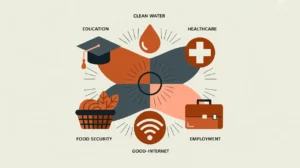Importance of Social Return on Investment
Social return on investment (SROI) provides a way to quantify the social, environmental, and economic value created by programs and organizations. It translates outcomes into financial terms, making them legible to funders, investors, and policymakers. For nonprofits and social enterprises, SROI matters because it strengthens accountability, communicates impact, and helps compare value across interventions.
Definition and Features
Social return on investment is an evaluation framework that assigns monetary values to social outcomes to calculate a ratio of benefits to costs. Its defining features include:
- Financial Proxies – uses economic values to represent outcomes such as improved health or reduced crime.
- Benefit–Cost Ratio – compares the value created to the resources invested.
- Stakeholder-Centered – outcomes identified and validated with those affected.
- Attribution – accounts for what portion of change is directly caused by the intervention.
- Standardized Process – guided by principles developed by Social Value International.
How this Works in Practice
In practice, an education program may calculate the increased lifetime earnings of graduates, reduced welfare dependence, and improved community health to show that every $1 invested generates $5 in social value. Nonprofits use SROI analyses in funding proposals, while investors rely on them to assess impact portfolios. Challenges include selecting appropriate financial proxies, avoiding oversimplification of complex outcomes, and the time and cost of conducting rigorous studies.
Implications for Social Innovation
Social return on investment aligns impact measurement with financial language, bridging the gap between social purpose organizations and investors. It supports innovations in blended finance, impact investing, and social enterprise by demonstrating tangible returns. For practitioners, SROI provides a structured way to link mission outcomes with economic value, ensuring that investments drive measurable and meaningful change.







